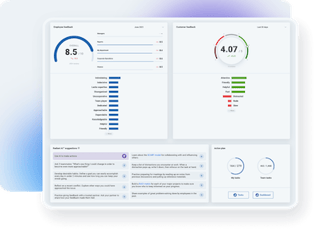
What is Survey Fatigue, and How to Avoid It
Employee surveys are a great tool to find out how employees feel about work. They’re a critical piece of any employee engagement initiative, and they help employers uncover and address issues that affect employee retention and company culture. Today, thanks to innovation in software technology, employee surveys can be delivered at a high frequency and results can be tabulated almost immediately. But, while technology has helped make surveys more accessible, it’s ironically created a new barrier to getting employee feedback: survey fatigue.
What is survey fatigue?
Survey fatigue happens when employees feel more annoyed by requests for feedback than they feel motivated to give feedback. There are two types of survey fatigue:
-
Survey response fatigue: This happens when employees fail to complete surveys because of the high number of surveys they’re asked to complete.
Example: Tim is sent multiple notifications to complete a feedback survey at the end of every company meeting. Tim does this a few times, but the notifications filling up his inbox every month start to wear on him. He starts ignoring the notifications so he can focus on other tasks.
-
Survey taking fatigue: This happens when employees fail to complete a survey because it takes too much time.
Example: Maria goes to complete her company’s annual engagement survey. She’s motivated to share her experiences. However, the engagement survey is 120 questions long, many of which are long and confusing, and Maria has many projects to work on. She gives up 20 questions in and doesn’t submit the survey.
What is the impact of survey fatigue?
The price of survey fatigue is high. When employees aren’t motivated to give feedback, the organization suffers two-fold: i) from missing out on valuable insight from employees, and ii) from decreased morale and faith in leadership. Survey fatigue happens when surveys are not seen as worthwhile efforts, and it quickly devolves into a cycle of indifference that hurts rather than helps employee engagement. Here are five ways to combat survey fatigue and help employees feel more engaged with your engagement surveys:
1. Keep it reasonable
It may seem counter-intuitive, but just because you can ask for feedback doesn’t mean you should in every instance. With modern software, we can easily deploy surveys and get the data right away, which makes it tempting to do so often, especially for those of us in people-centric roles. But remember, just because surveys are easier to deploy doesn’t necessarily mean they’re easier to complete. They still take time and effort from employees. If employees feel like they’re stuck in a never-ending cycle of surveys, they’re not going to stay motivated to give feedback, and your enthusiasm for good data might backfire into low completion rates and decreased engagement.
2. Keep it action-oriented
Survey fatigue often results from employees feeling disillusioned with previous surveys. This disillusionment most commonly stems from a perceived lack of action by leadership. If employees take time out of their busy schedules to provide feedback, only to see it disappear behind the leadership curtain and never manifest as meaningful change, it won’t take long for them to feel jaded toward any company survey.
Structure your survey around initiatives and actions that you’re motivated and equipped to put in place immediately. If you’re looking to increase employee engagement, design an engagement survey with questions your executive team is motivated to address. If you’re looking to define your culture and values, put a team in place to own that initiative first, then deploy the survey. Being motivated and equipped to act on survey results in a timely manner will be hugely effective at reducing survey fatigue.
Even the mere act of being transparent with employees about survey results can be a major step in the right direction. Employees will take notice if the CEO has an all-hands meeting to announce that the last survey uncovered a few problematic trends that need to be reversed. Even if no action is immediately taken, this lets employees know that their collective voice was heard, which means the next time they see a survey request, they’ll be more likely to feel it’s a worthwhile task.
3. Keep it simple
You know that frustration you feel when someone is trying to ask you something in a roundabout way, and you wish they would just get to the point? That is how your employees feel when they see long or ambiguous questions in your surveys.
If different people can interpret your questions (and results) in different ways, you’re not going to build confidence in your employee engagement survey. Even somewhat standard questions like, “Do you believe that management effectively addresses problems?” can be confusing from the employee’s perspective: should they be thinking about their direct manager when they answer this, or their department head, or the entire management team, or the CEO? Direct feedback that gives employees the opportunity to share their experiences with specific managers offers employees a clearer way to give feedback and produces more specific, actionable data for company leaders.
4. Keep it short
The employee survey experience varies greatly in length depending on the tool used. Many tools allow for 100+ questions, and let’s be honest: no employee wants that. Employees who are motivated to give thoughtful feedback face a huge burden with these lengthy surveys; whereas, apathetic employees can breeze on through with a uniform response of “Strongly Agree” or “Strongly Disagree.” You don’t want someone who cares to provide meaningful feedback to get so exhausted by your survey that they end up rushing to “get it over with,” or worse, abandoning it altogether.
This isn't easy with every survey. Shortening employee engagement surveys can be challenging because engagement-oriented questions often lack specificity, making it difficult to capture actionable data. This is why Macorva offers unlimited 360-degree feedback within every engagement survey, retrieving highly specific feedback in surveys that are short and simple.
The number of questions is not the only factor to consider when it comes to survey length. The accessibility of the survey also contributes to the overall time it takes for employees to give feedback. Solutions like Macorva that send employees text messages with magic log-in links to their engagement surveys save significant time over the standard workflow of logging into a work computer, checking email, and logging into the survey solution.
5. Keep it interesting
Another way to combat survey fatigue is to make your surveys exciting for employees. By empowering every employee to give and receive unlimited 360-degree feedback, Macorva makes every survey a unique, personal experience for every employee, so even the process of measuring engagement becomes a powerful way to improve engagement, instead of a boring necessary evil.
Streamlining engagements surveys and unlimited 360-degree feedback into one experience also empowers every employee, manager, and executive to take action on their own results, which means everyone in the organization has the power to make a difference for themselves and for their teams. While conventional engagement surveys highlight issues that can only be addressed at the top level with initiatives that take months or years to complete, personal reports of crowd-sourced feedback provide employees and managers with immediately actionable data. When every survey ends, employees can get excited about their personal results and improvement. As they discuss these results with their managers, they can see that their experiences with dozens of coworkers are helping shape the professional development of everyone in the office.
Avoiding survey fatigue
Survey fatigue is a natural response from your employees when giving feedback is time-consuming, confusing, and, from their perspective, meaningless. However, by taking steps to simplify, clarify, and condense your surveys, and by making action a focal point in your efforts, you can eliminate this barrier to employee feedback and get the data you need to increase employee engagement, improve retention, and foster a thriving company culture.





